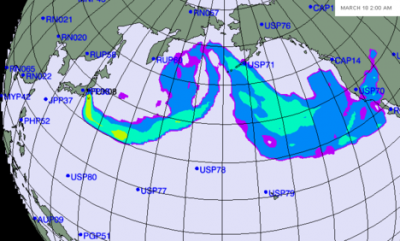Nuclear Fuel Fragment from Fukushima Found in Europe
The Nuclear Core Has Finally Been Found … Scattered All Over the World

Fukushima did not just suffer meltdowns, or even melt-throughs, It suffered melt-outs where the nuclear core of at least one reactor was spread all over Japan. In addition, the Environmental Research Department, SRI Center for Physical Sciences and Technology in Vilnius, Lithuania reported in the Journal of Environmental Radioactivity:
Analyses of (131)I, (137)Cs and (134)Cs in airborne aerosols were carried out in daily samples in Vilnius, Lithuania after the Fukushima accident during the period of March-April, 2011.***The activity ratio of (238)Pu/(239,240)Pu in the aerosol sample was 1.2, indicating a presence of the spent fuel of different origin than that of the Chernobyl accident.
(“Pu” is short for plutonium.) Fukushima is 4,988 miles from Vilnius, Lithuania. So the plutonium traveled quite a distance. Today, EneNews reports that a fuel fragment from Fukushima has been found in Norway:
Atmospheric Chemistry and Physics Discussions, Atmospheric removal times of the aerosol-bound radionuclides 137Cs and 131I during the months after the Fukushima Dai-ichi nuclear power plant accident – a constraint for air quality and climate models, May 2012: Hot particles (particles that carry very high radioactivity, e.g., fragments of the nuclear fuel) were present in the FD-NPP plume.
Elsevier (academic publisher) — Fukushima Accident: Radioactivity Impact on the Environment, Pavel P. Povinec, Katsumi Hirose, Michio Aoyama, 2013: Paatero et al. (2012) estimated that a significant part of the Fukushima-derived radioactivity is in hot particles from autoradiogram of a filter sample from 1 to 4 April 2011 at Mt. Zeppelin, Ny-Alesund, Svalbard. Poster for Alaska Marine Science Symposium (Arctic Ocean and Bering Sea/Aleutian Islands) — Fukushima fallout: Aerial deposition on the sea ice scenario and wildlife health implications to ice-associated seals, Jan. 20, 2014: Exposure to fallout while on ice in 2011[…] Models suggest pinnipeds may have been exposed while on ice to the following: […]Hot particles, nuclear fuel fragments, were detected in air samples taken in Svalbard, Norway (Paatero et al. 2012). See also: Gundersen: This video “confirms our worst fears” — Scientist: Reactor core materials found almost 500 km from Fukushima plant — 40,000,000,000,000,000,000 Bq/kg — Can travel very, very significant distances — Hot particles found in 25% of samples from Tokyo and Fukushima (VIDEO)
Fukushima is 10632 kilometers – or 6,606 miles -from Svalbard, Norway. Moreover, the distance is actually much further … because it took a circuitous route from Fukushima to Norway.As ENENews reports:
(Paatero et al. 2012) Journal of Environmental Radioactivity, Airborne fission products in the High Arctic after the Fukushima nuclear accident: It is evident that the plume arriving in Svalbard did not come from Europe but directly from North America […] [Hot particles are] either fragments of the nuclear fuel or particles formed by the interactions between condensed radionuclides, nuclear fuel, and structural materials of the reactor […] Based on the total beta, 137Cs and 134Cs activity content […] on the filter it can be estimated that a significant part of the activity related to Fukushima was in hot particles. So far the authors are not aware of any other reports concerning hot particles from the Fukushima accident. […] the radionuclides emitted into the atmosphere were quickly dispersed around practically the whole northern hemisphere within a couple of weeks.
The jet stream passes right over Japan. The jet stream was noticed in the 1920′s by aJapanese meteorologist near Mount Fuji, and the Japanese launched balloon bombs into the jetstream to attack America during WWII.
(Indeed, U.S. nuclear authorities were very concerned about the West Coast getting hit by Fukushima radiation … but they covered it up.) So the Fukushima hot particles traveled from from Japan to the West Coast of North America … and then were carried by wind currents from there. It’s approximately 5,000 miles from Fukushima to the closest part of North America. It’s another 4,298miles from San Francisco to Svalbard, Norway. So the hot particle traveled roughly 9,298 miles from Fukushima to Norway.



